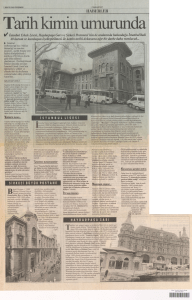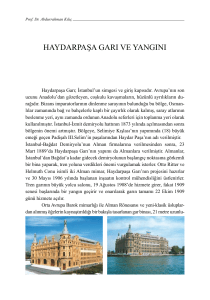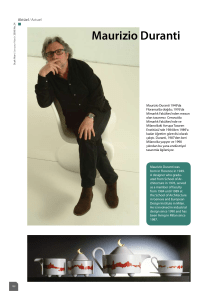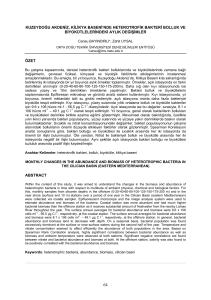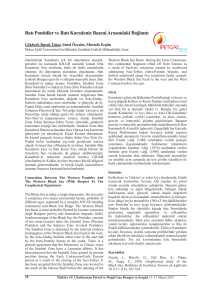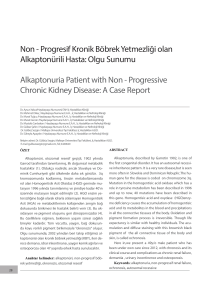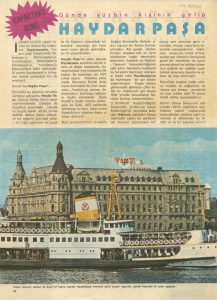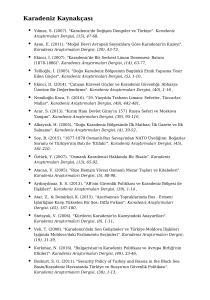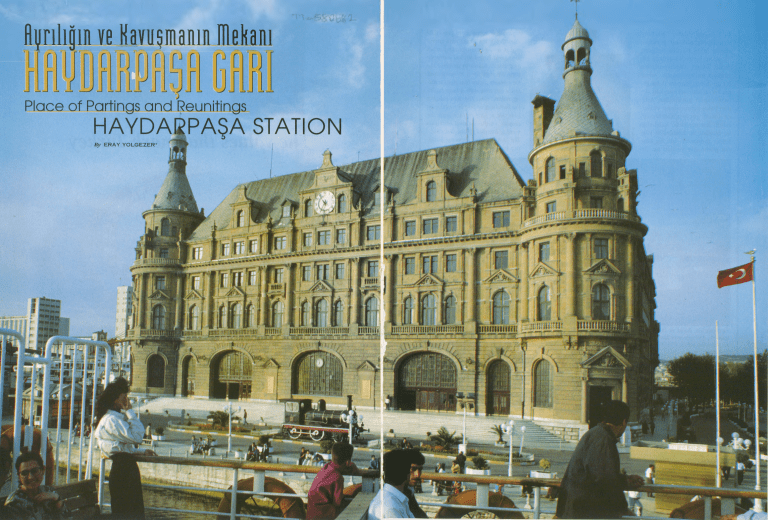
Ayrılığın ve Kavuşmanın Mekanı
A fa m ilia r scene from pre-1970
Turkish films: a young man carry­
ing a wooden suitcase passes
through a larged arched entrance
and slowly begins to descend the
steps. He stops fo r a moment, and
the camera shows him from a dis­
tance this time with a huge build­
ing behind him. The man watches
the hundreds of people rushing by
him. He is face to face with the
crowds, confusion and enchant­
ment of Istanbulfo r the first time.
The familiar and imposing build­
ing with the air o f a mediaeval
Cetısiz Cea
1970 öncesi yılların Türk film­
lerinden tanıdık bir görüntü;
elinde tahta bavulu ile genç
bir adam kemerli büyükçe ka­
pıdan ilerler, merdivenlerden
yavaşça inmeye başlar. Adam
bir an durur, kamera daha ge­
niş bir açıdan arkasındaki de­
vasa yapıyı görüntüler. Ada­
mın bakış açısından ise yüzler­
ce insan geçip gitmektedir:
bütün karmaşıklığı, kalabalığı
ve büyüsü ile İstanbul’la yüz­
leşme zamanıdır. İşte bu tanı­
dık görüntüde yeralan ve Or-
Haydarpaşa Garı, Osmanlı’nın 19. yüzyıldaki en büyük projelerinden biri olan Bağdat Demiryolu Hattı’nı görkemli bir yapıyla başlatma arzusunun
sonucunda, Almanlarla ortak finanse edilerek 1906-1908 yılları arasında yapıldı. / Designed by German architects and jointly financed by Germany,
the station was built in 1906-1908 as an imposing starting point for the Istanbul-Baghdad railway line, one of the largest 19th century Ottoman
infrastructure projects.
taçağ şatolarını hatırlatan mi­
marisi ile insanı hayran bıra­
kan yapı Haydarpaşa Garı’dır.
Haydarpaşa Garı, adını kurul­
duğu yerdeki çayırdan almak­
tadır. Mevacip defterlerine gö­
re, 1533 yılında vezirliğe kadar
yükselen Hadım Haydar Paşa’nın bahçesinden adını alan
semtin tarihi, İ7. yüzyıl tarihçi­
si Aramya Çelebi’ye göre Bi­
zans dönemine kadar uzan­
maktadır.
Bölgenin kaderi, 1873 yılında
îstanbul-îzmit demiryolu hattı-
castle is Haydarpaşa Station. It
is nam ed after the meadows
and orchards which were here
before the railway was built and
which according to the land
registers originally belonged to
H adım H aydar Paşa, who
became a vezir in 1533■ The
1 7th century historian Aramya
Çelebi records that in Byzantine
times there was a patriarchal
palace here.
The destiny o f the district was
altered fo r ever with the con­
struction o f the railway line
from. Istanbul to Izmit along the
eastern M armara Sea coast in
1873■ At the sea’s edge in Haydarpa§a a station was built fo r
the railway, which crossed the
m eadows a n d headed east.
Between 1899 and 1903 warehouses and a wharf for incoming
ferry boats were built here, and as
the railw ay exten d ed beyond
Izmit to other Turkish cities passenger numbers increased rapidly. Soon the station b u ild in g
became inadequate. ,
The Baghdad Railway was one of
J
I
I
I
I
I
I
I
I
I
I
I
I
Gülban Kırdı
mn açılması ile değişir. Çayırı
ikiye bölen demiryolu hattı­
nın son noktasına bir gar bi­
nası inşa ettirilir. 1899-1903
yılları arasında, depolama te­
sisleri ve deniz kıyısına inşa
edilen mendirekle birlikte gi­
derek önemi artan istasyon,
tren yolu hattının Anado­
lu’nun çeşitli şehirlerine doğ­
ru uzatılması ile yetersiz gel­
meye başlar.
Osmanlı devletinin 19. yüz­
yıldaki en büyük projelerin­
den biri Bağdat Demiryolu
Boğaz’a Marmara tarafından girildikten hemen sonra beliren ve büyük bir vakarla Avrupa yakasını gözler gibi duran Haydarpaşa Garı, yıllar boyun­
ca Anadolu’dan İstanbul’a gelenlerin varış noktası, İstanbul’dan Anadolu’nun ücra köşelerine gidenlerin uzun yolculuklarının ilk adımı olmuştur. /
Haydarpaşa Station comes into sight as soon as you enter the Bosphorus. For nearly a century this impressive building has looked across the strait
to Europe, and been the first sight of those drawing into Istanbul from the remotest corners of Turkey.
Hattı’ydı. Bu hattın başlangıç
noktasına görkemli bir yapı in­
şa etme arzusuyla gündeme ge­
len Haydarpaşa Garı, Almanlar­
la ortaklaşa finanse edildi. Otto
Ritter ve Helmuth Cuno adında
iki Alman mimar tarafından 30
Mayıs 1906 tarihinde yapımına
başlanan ve büyük yolcu salo­
nu 1908 yılında bitirilen yapı,
iki yıl içinde bütünüyle tamam­
landı.
Deniz üzerine çakılan 1100 ah­
şap kazığın üstüne oturtulmuş
the major projects o f the Ottoman
state in the 19th century, and a
fittingly imposing station to mark
the beginning o f this line across
Anatolia and south through the
Middle East was needed. H ay­
darpaşa Station was fin a n c e d
jo in tly by the Germans, a n d
designed by two German archi­
tects Otto Ritter a n d Helmuth
Cuno. Construction commenced
on 30 May 1906 and the main
passenger hall was completed in
1908. Construction o f the other
/
olan Gar binası, -mimarlarının
Alman olmasının da etkisiyleOrta Avrupa Barok mimarisi,
Alman Rönesansı ve Neo-Klasik üslupların eklektik bir ör­
neğidir. İki kolu farklı uzun­
lukta olan “U” planlı binanın iç
avlusu kuzeye bakmaktadır.
Merdivenler üzerinde yükseltil­
miş olan ve köşe kulelerinin
bulunduğu deniz cephesi ise
güneye bakmaktadır. Beş katlı
binanın her katındaki koridor­
lara sıralanmış olan odalar bü-
wings took a further two years.
The station building is built over
the sea and rests on 1100 timber
piles. Its architecture is an eclectic
m ixtu re o f central European
baroque, German renaissance
and neo-classical styles. The two
arms of the Uplan building are of
different lengths and face north­
wards aw ay fro m the sea. The
main seaward façade is flanked
by towers at the corners and a
broad flight of steps leads up to the
entrance. The upper storeys of the
Garın iç avlusuna açılan salonda, tavanlarla duvarların buluştuğu yerdeki bezeli furuşlar, kemer ayaklarındaki alçı kabartma barok bezemeler ve
renkli vitraylar olağanüstü güzelliktedir. / The passenger hall opening onto the central court of the station has decorative cornices, stucco relief
decoration in baroque style on the arch imposts, and stained glass windows.
I
ro olarak kulla­
nılmaktadır. Öz■ gün kalem işi
bezeli tavanları
ile dikkat çeken
odalardan bu­
gün
sadece,
“permi odası”
olarak kullanılan
mekan orijinal
haliyle durmak^ tadır. Köşe kule>----------------------
five storey build­
ing
contain
offices leading off
corridors. Origi­
nally these offices
h a d stencilled
ceilings, but today
only one preserves
its original deco­
ration. The comer
towers contain
circular rooms of
önder Durmaz
lerinde, üst katlara doğru küçü­
len dairesel planlı mekanlar yer
almaktadır. Güney cephesindeki
merdivenlerle yükseltilmiş plat­
formdan girilen ve peronların
bulunduğu iç avluya açılan sa­
londa, tavanlarla duvarların bu­
luştuğu yerde bulunan bezeli furuşlar, kemer ayaklarındaki alçı
kabartma barok bezemeler ve
renkli vitraylar olağanüstü gü­
zelliktedir. Kuzey tarafındaki av­
luda, çelik strüktürlü peron bö­
lümü bulunan binanın cephesi,
diminishing size.
The platforms are situated in the
centre o f the U shaped station with
access via the large passenger hall
which occupies the ground storey
of the main wing. There are mod­
ulions beneath the cornices
around the walls o f the passenger
hall, baroque stucco decoration
on the arch imposts, and stained
glass. The platforms are covered by
a steel structure, and the façade is
revetted in yellowish grey stone
from Bilecik.
Deniz üzerine çakılan 1100 ahşap kazığın üstüne oturtulmuş olan Gar binası, mimarlarının Alman olmasının da etkisiyle, Orta Avrupa Barok
mimarisi, Alman Rönesansı ve Neo-Klasik üslupların eklektik bir örneğidir. / Constructed over the sea on 1100 timber piles, the station has an
eclectic style combining Central European baroque, German renaissance and neoclassical.
Bilecik’ten getirilen sarı-gri
renkli lefye taşıyla kaplanmış­
tır.
Boğaz’a Marmara tarafından girildiktan hemen sonra beliren
ve büyük bir vakarla Avrupa
yakasını gözler gibi duran bu
dev yapı, 100 yıla yaklaşan ta­
rihinde bir dizi önemli olayın
ve şimdi adı-sanı bilinmeyen
yolcuların unutulmuş hikayele­
rinin sessiz tanığıdır.
Haydarpaşa Garı, Birinci Dün; ya Savaşı sırasında, 1917 yılının
Haydarpaşa Station becomes vis­
ible as soon as yo u enter the
Bosphorus Strait from the Mar­
mara Sea. Over the ninety years
since it opened, the station has
been silen t witness to m any
important events, and countless
passengers, both remembered
and forgotten. The station was
badly damaged on 6 September
191 7 during World War /, when
a m m u n itio n stored here fo r
transport to the front exploded,
and in 1979 another explosion
\
6 Eylül günü, Ana­
dolu’ya götürülmek
üzere garda depo­
lanmış olan cepha­
nenin patlaması so­
nucu ağır bir yara al­
mıştır. Kısa süre için­
de, çatısı dışında as­
lına uygun olarak
yenilenen Haydarpa­
şa Garı, motorlu araçların kullanımının yaygın­
laştığı döneme kadar İstanbul’un Anadolu yaka­
sındaki banliyölere yönelik en iyi ulaşım nokta-
Fuat Hüdaverdi
o f a Romanian tanker
o ff the mouth o f the
Bosphorus shattered
the original stained
glass windows.
As well as in tercity
trains, regular local
trains serve the sub­
urbs w hich stretch
dow n the M arm ara
coast on the Asian side o f Istanbul. The scene of the
provincial man with his suitcase arriving in Istan­
bul at Haydarpaşa Station is not a mere figment of
Haydarpaşa Garı, motorlu araçların yaygınlaştığı döneme kadar, Anadolu yakasındaki banliyölere yönelik en iyi ulaşım noktasıydı. En üstte, garın
tarihî restoranı görülüyor. / Although road vehicles have overtaken trains as the most popular way to travel to the suburbs along Istanbul’s Asian
coast, trains are still crowded at rush hours. The station restaurant (top) retains its turn of the century atmosphere.
siydi. Başta anlattığımız film sahnesi, sadece hayalgücü geniş sinemacıların filmografik bir imge­
si değildir. Gerçekten de, yıllar boyunca Anado­
lu’dan İstanbul’a gelenlerin varış noktası, İstan­
bul’dan Anadolu’nun ücra köşelerine giden as­
kerlerin, bürokratların, tüccarların, köyünün has­
reti ile yaşayan göçmen işçilerin uzun yolculuk­
larının ilk adımı olmuştur.
Haydarpaşa Garı onlarca yıldır, Doğu’nun gi­
zemli yollarına vurup gitmenin ayrılık valsi ve
İstanbul’un büyülü havasına kavuşmanın bitim­
siz telaşıdır.
•
the cinematic imagination, but a real part o f the
pattern of urban migration which has seen millions
of rural dwellers seek their fortune in Istanbul over
recent decades. Haydarpaşa Station is also the
starting point fo r those leaving home fo r distant
provincial towns and cities; fo r soldiers doing mili­
tary service, bureaucrats posted to the provinces,
and migrants going to visit loved ones back home.
Although cars and motorways have reduced the
importance o f rail travel, whether to the suburbs or
on intercity routes, the station is still busy, and still
an evocative landmark.
•
Eray Yolgezer, araştırmacı-yazar.
*Eray Yolgezer is a researcher a n d writer.
j
80
S K Y L IF E
O C A K a jp *
JA N U A R Y 1999
Kişisel Arşivlerde Istanbul Belleği
Taha Toros Arşivi
■İlil
* o o 1 s 8 o mm

